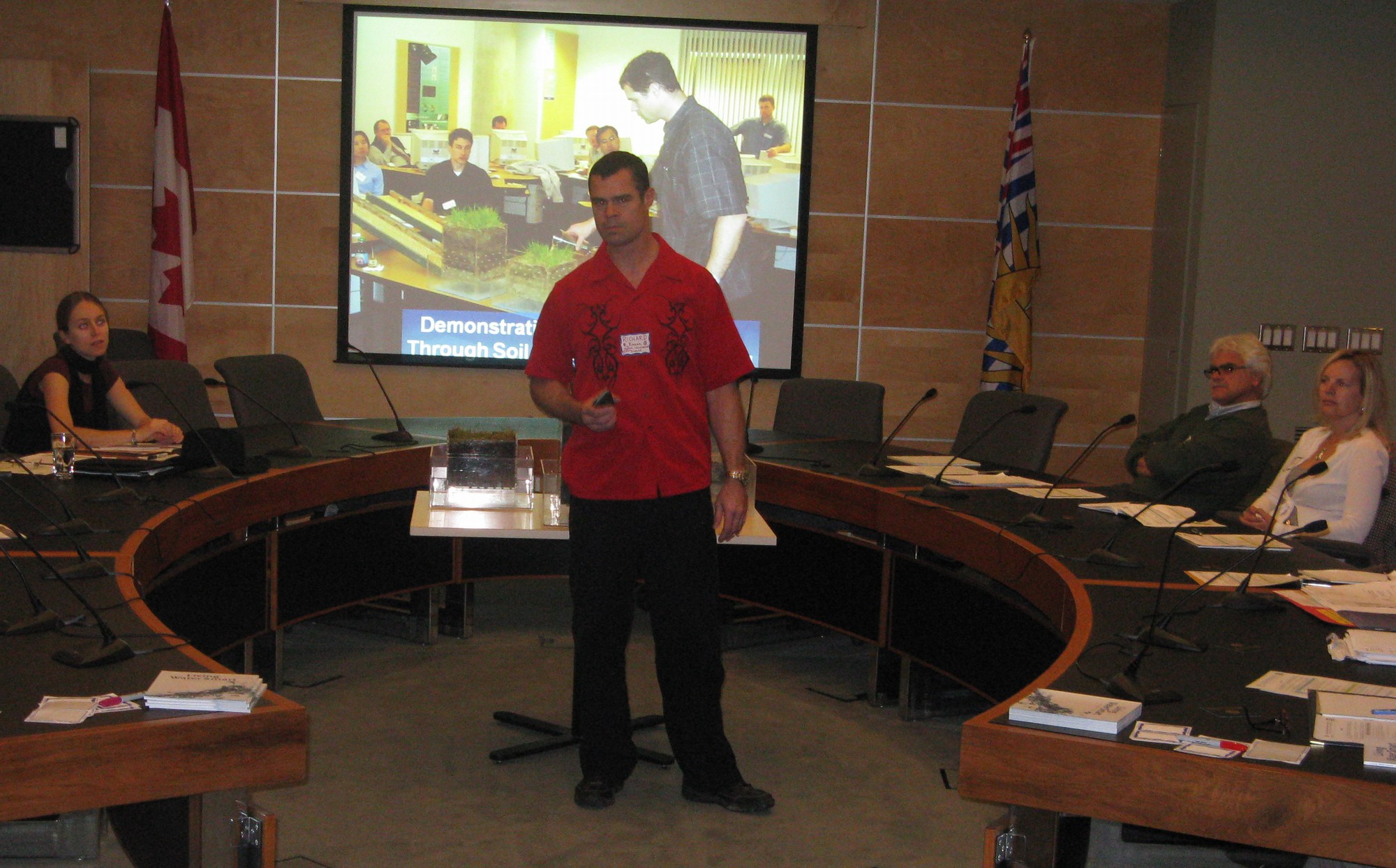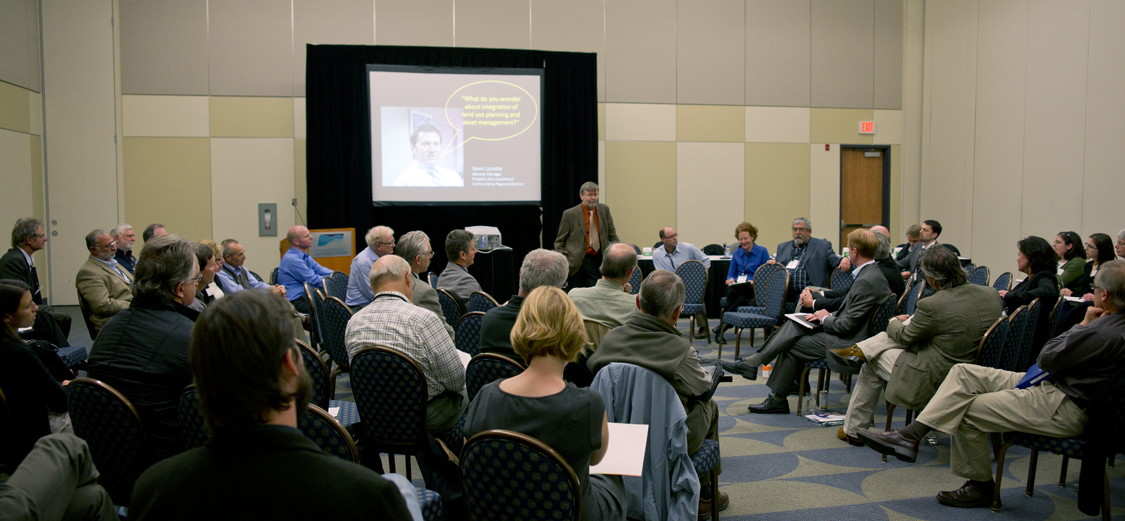“Think Like A Watershed”: 4-Person Teaching Team Integrates Regulatory, Historical, Local Government, Science and Technology Perspectives
Note to Reader:
On September 19, 2013 the Partnership for Water Sustainability in BC and the Association of Professional Engineers & Geoscientists of BC (APEGBC) are partnering to offer a seminar that integrates regulatory, historical, local government, science and technology perspectives on the subject of Sustainable Rainwater Management in British Columbia. To register for the seminar, visit the APEGBC website: click here.
The seminar program comprises six modules. To learn more about the scope and educational objective of each, click on Program Overview to download a concise synopsis.
Mimic the Water Balance to Protect Watershed and Stream Health!
Do you wonder what “sustainable rainwater management in a watershed context” looks like on the ground? Then register for the seminar on Sustainable Rainwater Management: Mimic the Water Balance to Protect Watershed and Stream Health. Engineering infrastructure, community planning and environmental professionals can all learn from the proven experience of those who are leading change .
On September 19, 2013 the 4-person teaching team of Kim Stephens, Richard Boase, Melony Burton and Jim Dumont will elaborate on what it means to “think like a watershed”. Presented together, their complementary perspectives provide a complete picture of sustainable rainwater management in a watershed context.
An Introduction to the Teaching Team
Relevant background and career accomplishments are highlighted below, and are complete with “quotable quotes”. To download a PDF copy of the set of Biographical Sketches for the team of Kim Stephens, Richard Boase, Melony Burton and Jim Dumont, click here.
About Kim Stephens
Kim Stephens is an engineer-planner and is the Executive Director of the Partnership for Water Sustainability in BC. His four decades of experience cover the spectrum of water resource and infrastructure engineering issues and applications, from master planning and modelling to implementation of capital projects. He specializes in public policy and has played a leadership role in a series of initiatives in British Columbia related to water sustainability, rainwater management and green infrastructure.
More than a decade ago, Kim Stephens looked at rainfall differently and developed the Water Balance Methodology that the Province subsequently incorporated in Stormwater Planning: A Guidebook for British Columbia. Since 2003, Kim has been responsible for developing and delivering the the Water Sustainability Action Plan for British Columbia, the partnership umbrella for a water-centric approach to community planning and development.
Kim Stephens has been invited to speak on “the BC experience” and make keynote presentations at forums in Australia and throughout North America. His work related to the UniverCity sustainable community at Simon Fraser University on Burnaby Mountain is featured in the book Dancing with the Tiger: Learning Sustainability Step by Natural Step, by Brian Nattras and Mary Altomare (2002).
Quotable Quotes:
“At the dawn of the 21st century, the mantra in British Columbia was ‘overcoming fear and doubt’ in order to move ahead with projects such as the East Clayton Sustainable Community in the City of Surrey, and UniverCity at Simon Fraser University on Burnaby Mountain in the City of Burnaby,” recalls Kim Stephens.
“Circa 2000, translating high expectations into practical design guidelines meant revisiting accepted drainage engineering practice. This need led to development of the Water Balance Methodology; and in turn the need to generate numbers led to development of the Water Balance Model as an extension of the Guidebook.”
About Richard Boase
Richard Boase is a geoscientist, and is the District of North Vancouver’s Environmental Protection Officer. He is also Co-Chair of the Water Balance Model Partnership. Richard is an innovator and is the District’s project manager for case study demonstration applications that have been driving the evolution of the Water Balance Model for the past decade.
Land redevelopment and densification to create the Lynn Valley Town Centre resulted in an applied research and implementation opportunity. The District of North Vancouver is pioneering the integrated application of performance targets for runoff management, at the neighbourhood scale, to protect stream health. Under Richard’s leadership, the District has also demonstrated the cost-effectiveness and power of imagery analysis as a rainwater management tool.
Richard Boase is the Water Balance Model Partnership’s lead for development of the web-based Water Balance Model Express for Landowners, and the District of North Vancouver’s Hastings Creek Watershed Blueprint is the demonstration application for this web-based tool. The Express has pre-set performance targets that are watershed-specific. This means that landowners will then be able to focus on the choices and the geometrics of fitting appropriate rainfall capture measures onto their properties.
Quotable Quotes:
“So many of us in local government are still searching for the magical ‘silver bullet’ that with the stroke of a pen will resolve all our watershed issues and challenges while at the same time stimulate economic activity and accommodate growth,” states Richard Boase.
“The time has come to make the hard decisions and to follow through with policy, regulations and bylaws that require simple, landscape-based, outcome-driven solutions so that we can start watershed restoration now.”
“We now have the tools and experience to ‘design with nature’. We believe that BC is now at a tipping point. Implementation of a new culture for urban watershed protection and restoration is within our grasp.”

Richard Boase shares his experience at the 2008 Vancouver Island Water Balance Model Forum hosted by Cowichan Valley Regional District
About Melony Burton
Melony Burton is the Watersheds & Drainage Coordinator for the City of Coquitlam. She has been with the City for 10 years. Previously, she worked for the City of Victoria Engineering Department. She has a Diploma of Technology in Civil and Structural Engineering from BCIT as well as an Associate Degree of Science from Thompson Rivers University.
Melony Burton is responsible for Coquitlam’s Capital Drainage program which includes utility planning, infrastructure management, facility expansion, and rehabilitation projects. She has worked on 9 Integrated Watershed Management Plans as well as several large projects coming out of the recommendations. She has been actively involved in developing and implementing the City’s rainwater management policy and promoting stormwater initiatives.
Melony Burton is the Alternate Chair for the Metro Vancouver inter-municipal Stormwater Interagency Liaison Group (SILG). In this capacity, she has played a lead role as a member of the inter-governmental and multi-disciplinary working group that was tasked with developing a Monitoring & Adaptive Management Framework that will meet the Minister of Environment’s conditions of approval for the watershed management component of the Metro Vancouver Integrated Liquid Waste & Resource Management Plan. These conditions link land use planning to stream health.
Quotable Quotes:
“The City of Coquitlam has Integrated Watershed Management Plans completed or underway for all of its watersheds,” states Melony Burton. “Coquitlam’s Official Community Plan requires that a Watershed Plan be completed before a Neighbourhood Plan can be developed. This important direction guides appropriate land use in response to a watershed’s unique conditions and needs.”
“Using this strategy has brought our Planning, Environmental, Engineering, and Parks departments to the table. Both the process and the plan are integrated to achieve practical, cost-effective objectives which balance land use, drainage and the environment.”
“The seminar is an opportunity to share lessons learned by the City of Coquitlam over the past decade. Changing the way we do things means taking on new challenges and not always getting it right the first time. Securing political support for a watershed-based approach to community planning paved the way for development and implementation of rainwater management applications that mimic the Water Balance.”
“Over time, our Integrated Watershed Management Plans will be guided by a Monitoring and Adaptive Management Framework which will allow us to evaluate which strategies are yielding the most positive results and which need modification.”
About Jim Dumont
Jim Dumont is the Engineering Applications Authority for the Water Balance Model Partnership. He is a recognized specialist in hydrologic modeling and infrastructure engineering. For many years, he has been teaching water resource and modelling seminars as part of the professional development program provided by APEGBC.
Jim Dumont evolved the Water Balance Methodology to address the relationship between rainfall volume control and resulting flow rates in streams; and developed the Stream Health Methodology as the technical foundation for the provincial ‘Beyond the Guidebook’ initiative in 2007. This methodology correlated stream erosion as a measure of stream health.
Jim Dumont’s innovation and many accomplishments as Engineering Applications Authority encompass creation of the technical foundation for both the Water Balance Model Express for Landowners and Drainage Infrastructure Screening Tool.
The latter is web-based and embeds a common-sense engineering methodology that allows local governments to quickly and efficiently assess the hydraulic performance of storm sewer systems, carry out redevelopment and climate change scenario comparisons, generate immediate answers and establish priorities for detailed analysis and capital planning purposes.
Quotable Quotes:
“The methodology integrates the components of the water balance, and assesses how they change as the percentage of hard surface increases: runoff goes up; infiltration and surfaceevaporation both go down. Evaporation is critical and typically gets overlooked in conventional drainage modelling,” explains Jim Dumont.
“What most people overlook is that evaporation is almost equal to infiltration. This means there is increasingly more volume to manage as the landscape is built over.”

Jim Dumont elaborates on the Water Balance Methodology at a training workshop organized by the Okanagan Basin Water Board in 2012




